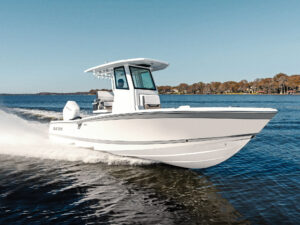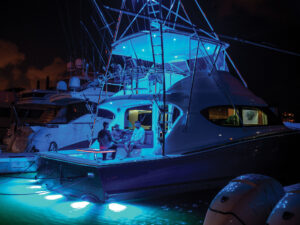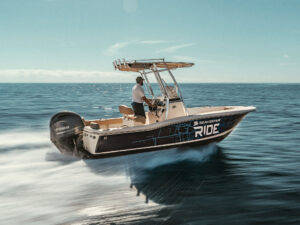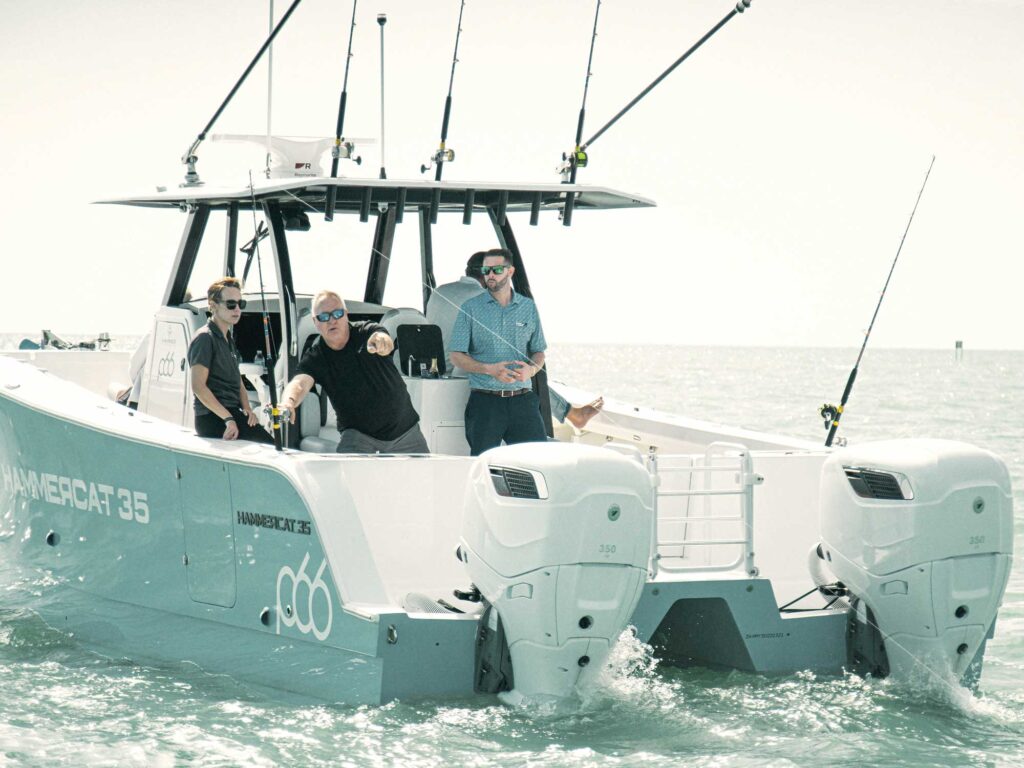
I admit that as a serial diesel owner, I had scoffed at the idea of a diesel outboard. My mind conjured up a smelly, smoky, low-revving motor. Boy, was I wrong. After I tested the new Cox 350 diesel outboard, I realized how Wilbur must have felt when he saw Orville lift off and fly for the first time. A follow-up to the Cox 300, the Cox 350 diesel brings a new perspective to outboard power. Cox Marine unfolded a blank sheet of paper and then worked backward. Let’s look closer.
Fuel
For starters, the Cox 350 consumes about 30 percent less fuel than gas outboards. A legit comparison shows a 425 hp gasoline engine drinking about 37 gph, while the 350 sips just 21 gph. Yes, diesel fuel is more expensive. But diesel is still the winner, meaning you can run a lot farther with the same fuel tank.
Punch
At 2,600 rpm, a 425 hp gas outboard puts out about 400 pound-feet of torque, while the Cox 350 puts out 776 pound-feet of torque. Whether you’re headed to the islands for a few days and then back again, or just running a heavy boat full of anglers, the Cox delivers a big difference when it comes to power.
The Build
As a purpose-built V-8 package designed around a blank sheet, this new 350 allowed Cox to solve some issues. For example, its twin turbos create the prior-mentioned torque at low rpm.
A vertical crankshaft is more efficient, with a direct drive to the transmission without any power-eating gears. Because it is lubed with oil down to the splines continually, it has reduced wear. And it reduces the package size of the outboard, which translates to closer spacing for multiple outboard rigs. Cox also designed its own power tilt and trim system from the skeg up, which takes advantage of this closer engine spacing.
Compatibility
The Cox 350 uses standard props with a 1.25-inch-diameter shaft and 19-tooth spline, so a world of interchangeable props are available. The 30-inch transom bolt pattern is also universal, so you can easily retrofit with a Cox or two without having to rebuild your transom. This is a straightforward switch. The motor comes in three shaft lengths: 25-, 30- and 35-inch to meet every possible transom height. And because the Cox 350 is fully NMEA 2000-compatible, it is plug-and-play with nearly every standard dash monitor you might have aboard—no dumping your touchscreen for something new. In addition, every 350 is provided with a full-color LCD engine display, with a touchscreen optional.
Sustainability
You may not be worried about the ecosystem when you put the hammer down to get to your favorite fishing grounds, but the ocean would like to thank Cox for its low emissions, up to 36 percent less CO2 than gas outboards. The 350 has also received EPA Tier 3, RCD II and IMO II certifications, making it hands-down the most environmentally friendly high-horsepower outboard available.
Safe and Easy
A clever feature of the 350 is wireless ignition, giving anglers the freedom to start the engines from anywhere on board. The same system also has a man-overboard detection system that shuts down the engines if a crewmember falls in the drink.
Read Next: How to Choose an Outboard Brand
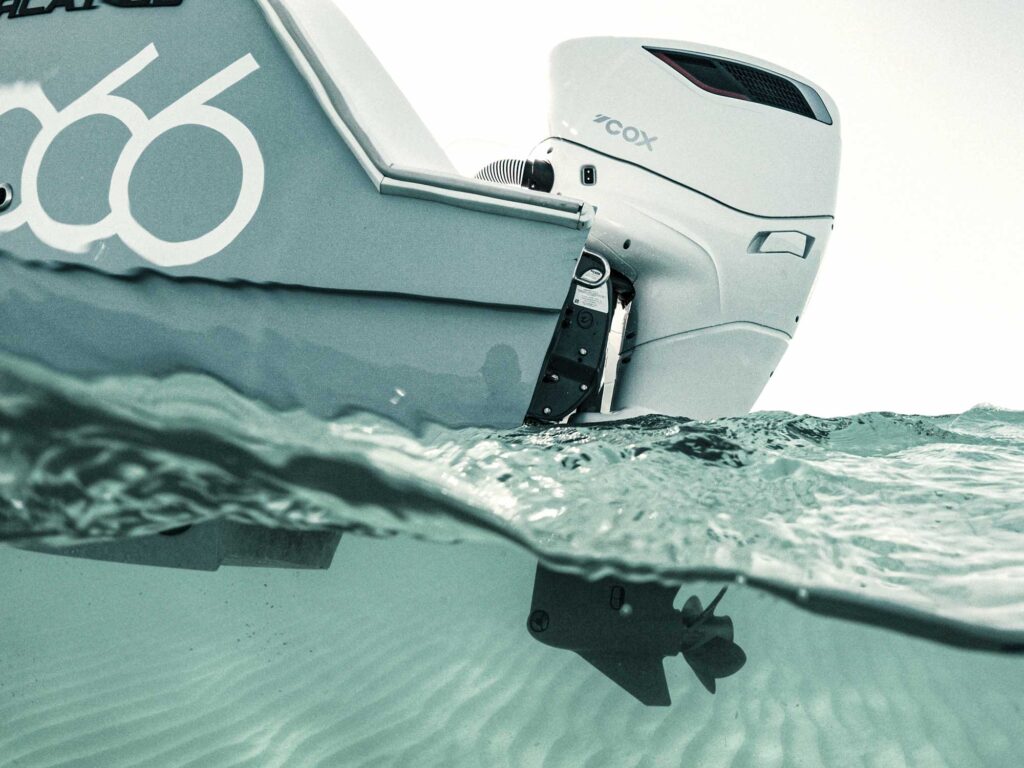
Hands on the Wheel
Optimus electric steering from Dometic is standard with the Cox 350, which is fully programmable to set the lock-to-lock turns required to suit your steering needs. And the wheel effort is programmable as well, if you want a stiffer or lighter feel to the wheel.
All About Service
Cox’s 350s have a flat five-year/1,500-hour warranty for recreational use, while commercial users, such as workboats, and fire-rescue and commercial fishermen, get a 12-month/1,000-hour warranty top to bottom.
What about service? A global supply network of 175 territories provides full parts support, technicians and service training. Even better, the Cox 350 has a 250-hour service interval, and that’s just for fluids and adjustments. Sorry, you won’t be getting any Christmas cards from your local mechanic.
Fuel Availability
Here’s where the Cox 350 really gets interesting. It dines happily on standard diesel fuel from every fuel dock. But it also runs on other fuels, such as HVO (hydro-treated vegetable oil), a synthetically produced fuel processed using renewable waste lipids and no petroleum resources. So, yes, in theory you can empty out the french-fryer at your local McDonald’s, remove the fries, and power your 350. This motor also likes the flavor of jet fuel, available at every airport in the world.
So, Who’s Using It?
In the recreational market, builders such as Jupiter, Freeman, Albermarle and Intrepid are already on board with Cox outboards. The US Coast Guard is using Coxs on its new Boston Whaler 37 Justices, and the Fort Lauderdale Marine Patrol has a pair of RIBs with them.
So, What’ll It Do?
Our test platform was a Hammercat 35, a new center-console catamaran from South Africa. Not only is this an extremely cool challenger in the cat world, but it’s also the perfect platform for testing the Cox 350. With both 350s hung on the widely spaced transom, two 200-gallon tanks half-full, and five large-ish people aboard, we weighed in at about 9,000 pounds.
In moderately lumpy water, we topped out at 50 mph (44 knots), but that wasn’t the eye-opening part of the engine’s performance. Granted, the Hammercat is slippery in the water, but the torque brought us flat to plane at 18 knots. At 2,450 rpm, we were cruising comfortably at just shy of 20 knots while consuming only 13.3 gph. That would get us to the offshore fishing grounds in fine style, with a range of around 600 nautical miles, which is a lot farther than I really want to go.
I put the throttle down a bit further, and we were getting 30 mph at 2,900 rpm and just 19 gph. I pushed harder, and 3,000 rpm was good for 36 mph and 29 gph. Even better, I was reading just 63 decibels on my sound meter at the helm, so conversation was at a normal level without diesel clatter in the background, with virtually no diesel exhaust smell.
I have already admitted that my preconceived notion of a diesel outboard was totally wrong. I loved the Cox 350—loved its power, its economy, its thoughtful design and, of course, that it’s helping save the world.
Take a test ride, and you’ll feel like Wilbur too.
Specifications
| Power at Prop: | 350 hp |
| Torque at Prop: | 776 lb.-ft. |
| Engine: | 60-degree V-8 |
| Displacement: | 4.4L (266 cu. in.) |
| Dry Weight: | 866 lb. |
| Gear Ratio: | 1.46:1 |
| Warranty: | Five years (recreational) |

